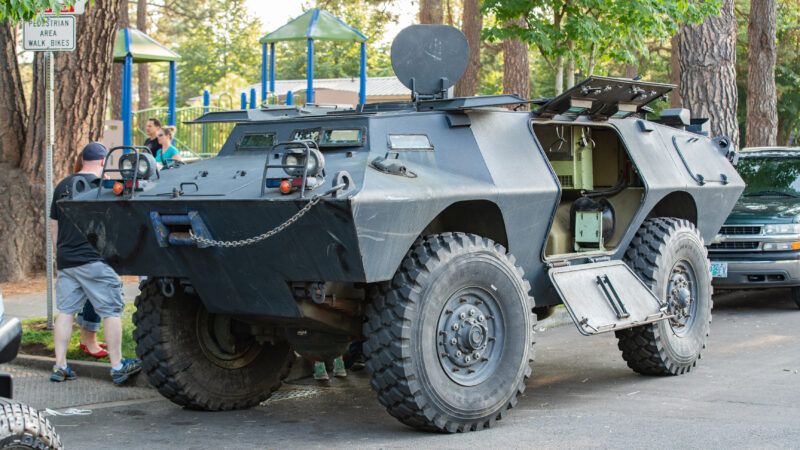Civilian Cops Don't Need Military Weapons
Police are supposed to be part of a community, not an occupying military force armed to the teeth.

I recently was driving behind a pickup truck that sported a bumper sticker with a U.S. Marine Corps logo and these words: "When it absolutely positively has to be destroyed overnight." That line got me thinking about policing—and the vastly different roles between the U.S. military and the nation's civilian police forces.
The goal of the military obviously is to subdue a nation's enemies. The U.S. military has engaged in many misbegotten exercises that try build nations rather than destroy them, but they rarely go as planned. That's because military forces are not really trained to create court systems and hold elections. If they were, that bumper sticker wouldn't even be mildly funny.
Since the start of the drug war in the 1980s and following the 9/11 attacks in 2001, our nation has increasingly blurred the distinction between the military and domestic police departments. Local police forces train their recruits as if they are patrolling the streets of Baghdad, and then equip them with surplus equipment from the latest wars.
This trend is dangerous and to some degree explains the frustrations that sparked national police protests. A Department of Justice report following a police shooting in Ferguson, Missouri, found that officers "demand compliance even when they lack legal authority" and "interpret the exercise of free-speech rights as unlawful disobedience, innocent movements as physical threats, indications of mental or physical illness as belligerence."
In short, Americans don't like to be treated as if they are living under occupation. Not all police officers or departments operate that way, but it's common enough—and that authoritarian approach is at odds with the policing we should expect in a democratic society.
"The streets of America are not some far-off battlefield, and our police are not an occupying force," the Project on Government Oversight explains. "The military's function is to fight foreign enemies, which requires specialized weapons, gear, and tactics. Domestic police, however, are meant to protect individuals and uphold the rights that every American is afforded under the Constitution."
That seems obvious, and yet the Pentagon's 1033 program has sent $1.5 billion in decommissioned military hardware—firearms, Mine-Resistant Ambush Protected (MRAP) vehicles, and aircraft—to local departments. (I once interviewed the head of a law-enforcement agency who refused such equipment because whenever departments received such toys, he said his officers would be too eager to use them.)
The Defense Logistics Agency seems proud of the program, as its website features stories of Texas police who deployed an MRAP during a SWAT raid and a Michigan department that used a personnel carrier to deal with dam breaks. No one is upset at the use of equipment during natural disasters, but some departments use military vehicles to serve simple warrants.
Last month, Congress had a chance to rein in this program. But the House of Representatives rejected, on a 198-231 vote, an amendment to a national defense authorization bill that would have limited these 1033 equipment transfers. It was a timely proposal given that the pullback in Afghanistan means that there's going to be more surplus equipment. Inexplicably, Joe Biden has opposed even modest restrictions on the 1033 program, which echoes the position of the former Trump administration.
The amendment was reasonable. It would have forbidden the transfer of "controlled firearms, ammunition, bayonets, grenade launchers, grenades (including stun and flash-bang) and explosives" as well as MRAPs, armored and weaponized drones and aircraft that "have no established commercial flight application." I'm still not sure why local police and sheriffs' departments need grenade launchers and weaponized drones, but call me old-fashioned.
"Our neighborhoods need to be protected, but Americans and our founding fathers opposed blurring the line between police and the military," said sponsor Rep. Hank Johnson (D–Ga.). Conservative Rep. Tom McClintock (R–Calif.) co-sponsored the amendment. However, few other Republicans recognized the dangers of an overly militarized police force—or perhaps they are too frightened of police unions to do the right thing.
Police agencies might believe they need military equipment because of potential terrorist attacks or efforts by violent drug gangs, but those are rare occurrences. The equipment typically is used in the course of everyday police work. Those are just excuses departments use to acquisition this "cool" stuff. They are free to the departments, but they often impose maintenance burdens. I can only imagine the cost of an MRAP engine rebuild.
Recent peer-reviewed studies show that the use of such equipment doesn't reduce crime or protect officers. Instead, such military cosplay teaches officers to view the citizenry as subjects who must blindly submit to their authority, inflates the dangers officers face, and encourages cops to take unnecessarily aggressive actions, especially during public protests.
It heightens antagonism between the police and the communities they protect and serve. That's not surprising given that police are meant to build bridges within their communities—not destroy them.
This column was first published in The Orange County Register.


Show Comments (78)